Traditional top-down sales enterprise motion has dominated the B2B go-to-market for decades. A traditional sales funnel is the following: find enterprise buyers, pitch products, close contracts, and onboard users. Yet sales funnel performance is deteriorating, with sales systematically missing top-down quotas and marketing teams caught up in the MQL (Marketing Qualified Leads) death spiral. What changed?
Acquisition channels are saturated and overloaded: The average buyer gets 10+ email/social cold outbounds daily, making it impossible to get noticed.
Cost of acquisition is increasing: increased channel accessibility and competition drive costs through the roof.
Channel lifecycle is shortening: the lifecycle of any creative or strategy is a few weeks, at most, needing constant creative inflow.
Buyer face decision hesitancy: low-utilization, top-down product decisions have burned buyers.
End-users earned new powers: end-user has gained decision-making power in the organization (or at least a seat at the decision-making table).
This opened an opportunity for companies to enter organizations through end-users, not enterprise buyers, giving rise to product-led sales.
What is Product-Led Sales
The Product-led sales (PLS) strategy emphasizes enabling end-users to discover and experience the product's value through self-serve usage, which then serves as the basis for promoting enterprise-level upgrades and expansions. In other words, with PLS, end-user usage is the basis for pipeline creation vs. in traditional enterprise sales flow usage is the end goal of a successful contract close.
More details in my Endgame.io guest post here.
Start with Product-Led Growth
The product-led growth (PLG) model is a prerequisite to enable product-led sales. The creation of self-serve usage forms the foundation of the sales pipeline creation.
Product-led growth is characterized by a product's capacity to self-serve activate, engage, and monetize users. User must:
Be motivated to solve the problem
Have the ability to do it self-serve
Have permission from the organization to solve the problem
The product-led acquisition can be unlocked if the product has a strong viral or content growth engine, but many B2B companies lean on marketing to solve acquisition.
Check out Leah’s Product-Led Growth Guide here.
Product-Led Sales Target Segments
Does this mean traditional enterprise motion is dead? Absolutely not. Product-led sales and sales-led motions shine best in different segments.
The most common segmentation in B2B is based on the company size of the customer:
SMB segment (small businesses): 1-100 employees.
Mid-Market segment: 101-1000 employees.
Enterprise segment: 1001+ employees.
Employee size provides the strongest correlation to the average contract value (ACV) business can sustain. Larger companies inherently face more complexity and are willing to pay more for solutions.
SMB
SMB has long been dominated by self-serve payment because:
Self-serve experience can solve their lower problem complexity.
Lower ACV’s make it unfeasible to assign a sales representative to the process and still generate a profit.
This segment prefers a self-serve journey.
Mid-market
Mid-market segment has undergone the biggest transformation, previously owned by traditional sales but now transitioning to product-led sales.
Users have permission to try out products
The company is not tightly regulated yet
Enterprise
The enterprise segment is still predominantly owned by traditional sales-led motion. Large company sizes have:
Strong centralized budget control
High demand for security, taking away permission from users to explore
End-users aren’t motivated to solve enterprise-wide problems
Human intervention in peaking buyer’s interest is necessary even to run a pilot in enterprise organizations.
However, product-led sales are beginning to disrupt the enterprise segment. Companies like Figma, Miro, and even Amplitude are finding their way into enterprises through end-user, escalating to six-figure contracts with product-led sales.
Converting Usage to Product-Led Sales
Not all product usage can be converted to sales pipeline creation.
Product-led sales journey starts with individuals coming to the product to solve the problem. But the company won’t buy $15K worth of software for one user. So how do you escalate individual usage to enterprise pipeline creation?
The key is to acquire users but optimize products for team value. This means:
Setting Acquisition, Activation, Engagement, and Monetization metrics on a team level.
Lead with a team use case, messaging, value, and plans.
‘Team’ plan with one user > ‘Individual’ plan.
Enabling collaboration and multi-user adoption.
Creating team network effects, where each additional new team user benefits the entire existing team.
Network effects can be achieved through collaboration or content.
Team focus gives a necessary escalator for taking individual users all the way to enterprise value that sales will work on capturing.
End-user is Not a Lead
Product-led sales cannot be jammed into a traditional top-down enterprise sales playbook. A new user does not mean you have an MQL (marketing qualified lead) for sales to begin prospecting. Yet many companies flood sales with freshly signed-up end-user ‘opportunities.’ The situation ends up looking something like this:
Product Qualified Accounts (PQA)
In product-led sales, the product determines Product Qualified Accounts (PQA) to indicate when an account is prepared for sales engagement and potential conversion. Product usage signals are gathered across:
Usage volume
The breadth of feature usage
The velocity of usage (i.e. big influx of new users)
Behavioral components (i.e. visiting ToS pages)
PQA is ultimately about timing and knowing when sales should reach out based on a combination of product signals.
PQA may look like a simple score, say 1-100, which predicts the propensity of the account to materialize into a sales opportunity. The higher the score, the higher the chances of successful pipeline creation. Set the threshold of PQA where the account is a prime time target for sales (i.e. score of 80+). Ideally, it is calculated daily, giving sales hot-off-the-press information about the account's readiness to engage in the conversation.
More details in my Endgame.io guest post here.
Product Qualified Leads (PQL)
PQLs, or Product Qualified Leads, are the people within the existing self-serve user base with buying power.
The biggest mistake companies make is assuming that users are ready to talk to sales just because they are engaged with the product.
But most self-serve users are not enterprise buyers. At most, they can be champions and should be approached as partners to sales, not leads.
The biggest product-led sales unlock happens once:
The company clearly identifies the enterprise buyer persona.
Understands whether buyers are present in the user base.
If the buyer is in the user base
And the account is in PQA: sales are deployed to sell into the account.
And the account is not in PQA: success reaches out to the buyer to offer a white glove activation/engagement experience to ignite sales conversation.
If not, deploys the appropriate strategy to acquire buyers: Account Based Marketing (ABM) and sales prospecting.
The entire team journey ends up looking like this:
Product-Led Sales Team Structure
In B2B sales organizations that follow a traditional top-down approach, the product team develops products and features, which are then handed over to the marketing and sales teams to sell. The marketing and sales teams are primarily responsible for generating revenue and have the strongest relationships, while the product team supports their efforts. These companies allocate more than 70% of their expenses to sales and marketing.
On the other hand, in product-led sales organizations, the product team plays a more active role in acquiring and creating a sales pipeline, resulting in stronger relationships between product and sales. Marketing's main responsibility is to enable the product and sales teams to succeed. Such companies allocate more than 60% of their expenses to product and engineering.
In PLS companies:
The product is accountable for both free and paid user health
The product is accountable for self-serve activation of end-user
The product has to be able to sell itself
The product is accountable for the self-serve revenue target if self-serve payment is available
Product is accountable for the pipeline by growing PQA’s
Product-Led Sales Teams
In a traditional top-down sales approach, the sales team is motivated to close the largest and newest deals to account for the high acquisition cost and ensure profitability.
In contrast, in a product-led sales approach, the sales team gets involved with the account much earlier in the problem lifecycle, and the initial contract value is smaller. It's important to note that in top-down sales, the buyer is typically captured during the high maturity stage of the problem. In contrast, in product-led sales, the account is acquired earlier in the lifecycle. Therefore, the landed annual recurring revenue (land ARR) is not comparable between the two channels. Product-led sales' primary goal is to expand by continuously growing with the account, which is where most of the revenue is generated. Overselling the account during the initial contract can be detrimental as it may disrupt the expansion journey.
Expansion ARR, not land, heavily incentivizes the resulting sales comp in PLS sales.
Afterword
The B2B is currently experiencing a significant transformation, as enterprise buyers now expect to recognize the value of a product or service before finalizing a transaction. While product-led growth (PLG) may not universally apply to every industry or market segment, its rising popularity cannot be ignored. As a result, every organization should evaluate product-led sales as a potential go-to-market strategy to remain competitive and adapt to the evolving market landscape and customer expectations.

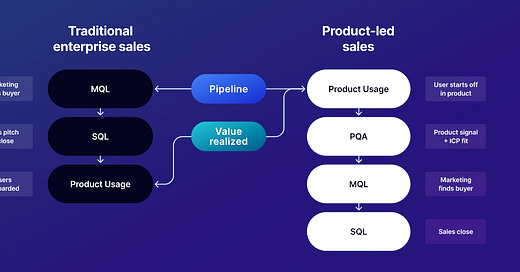





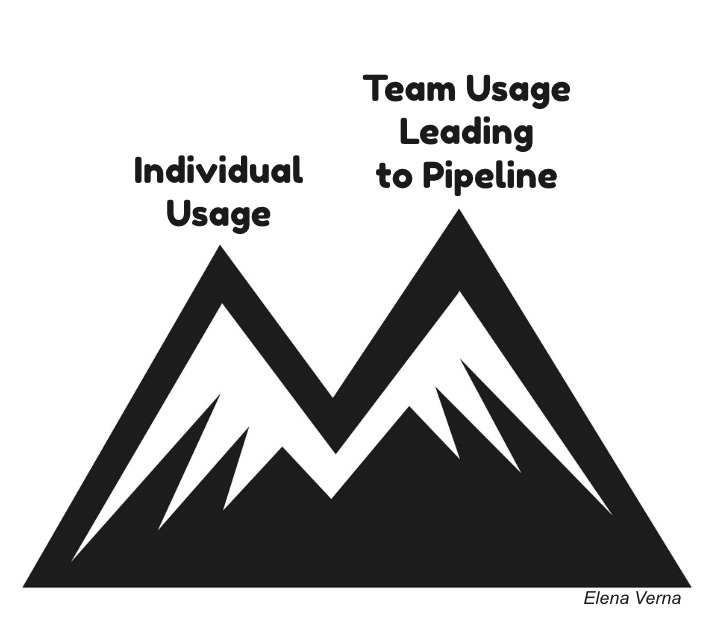
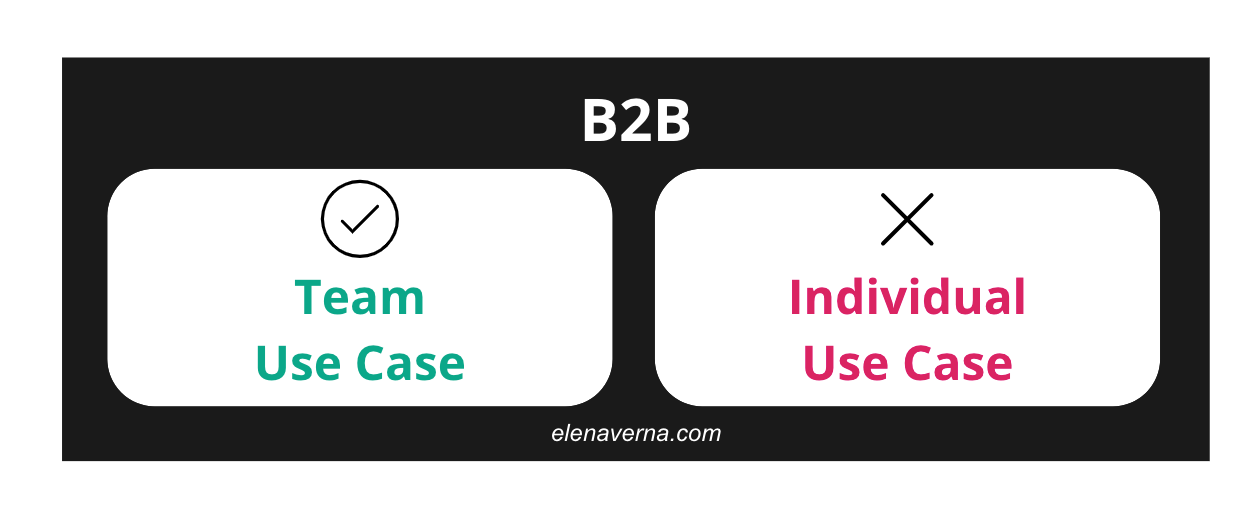
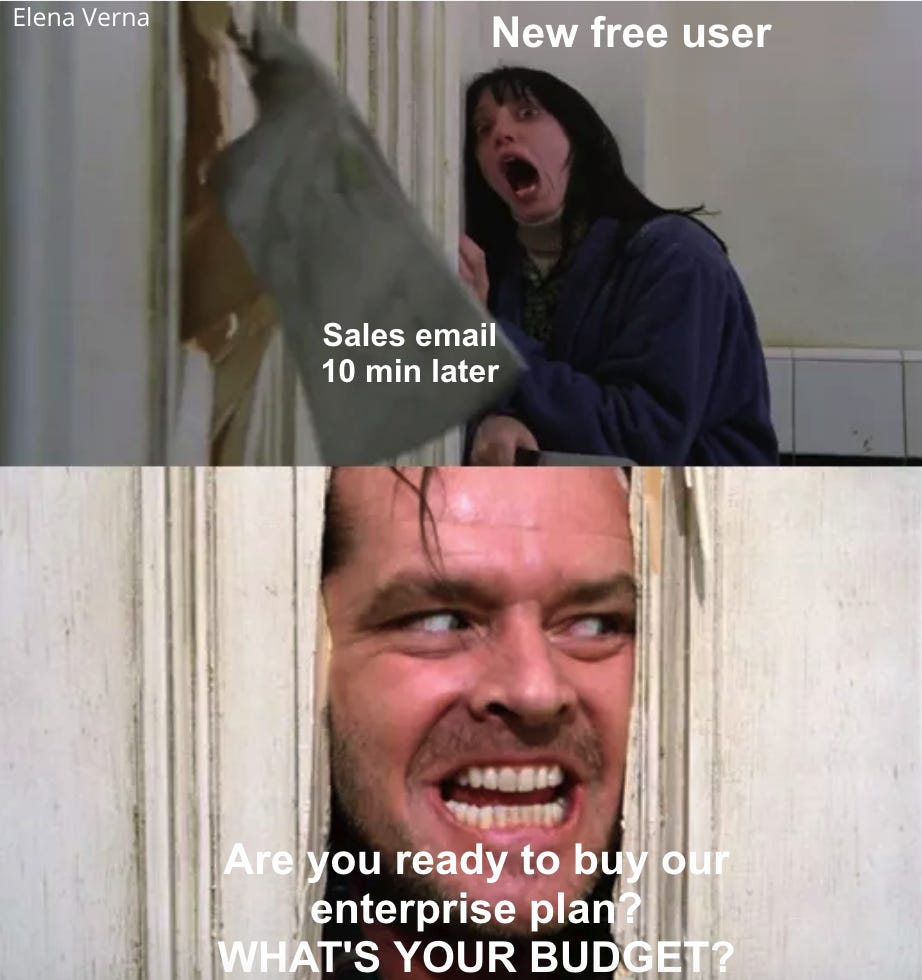
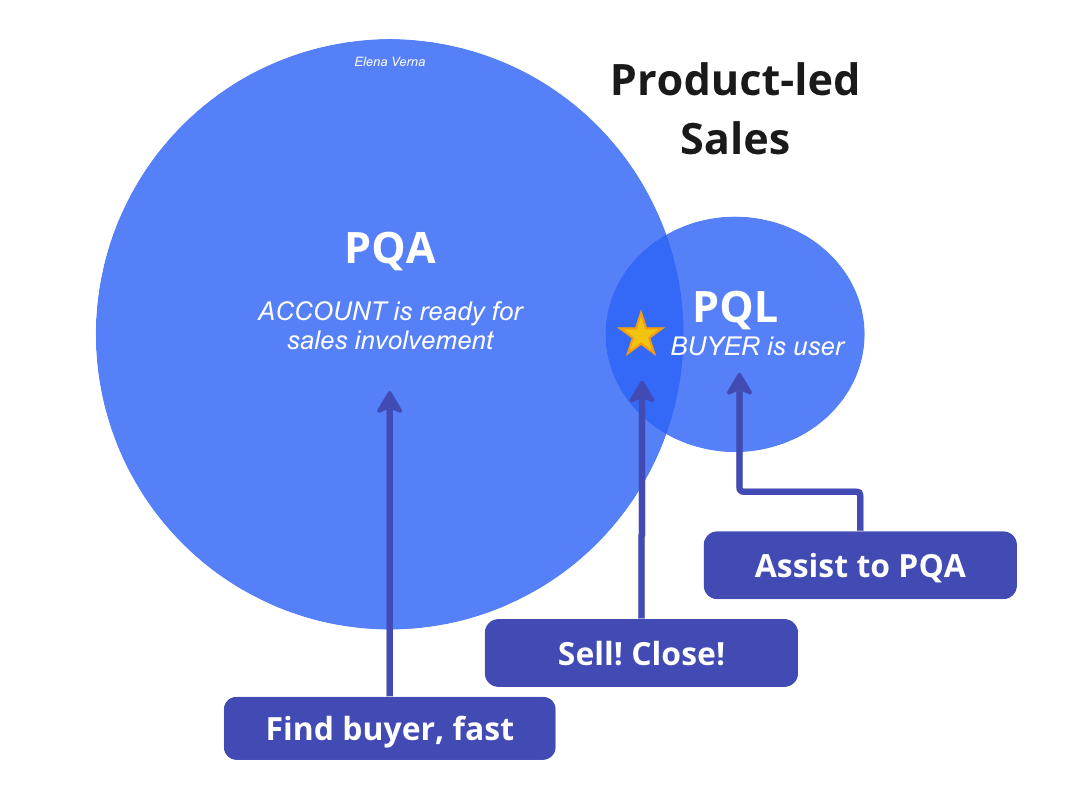

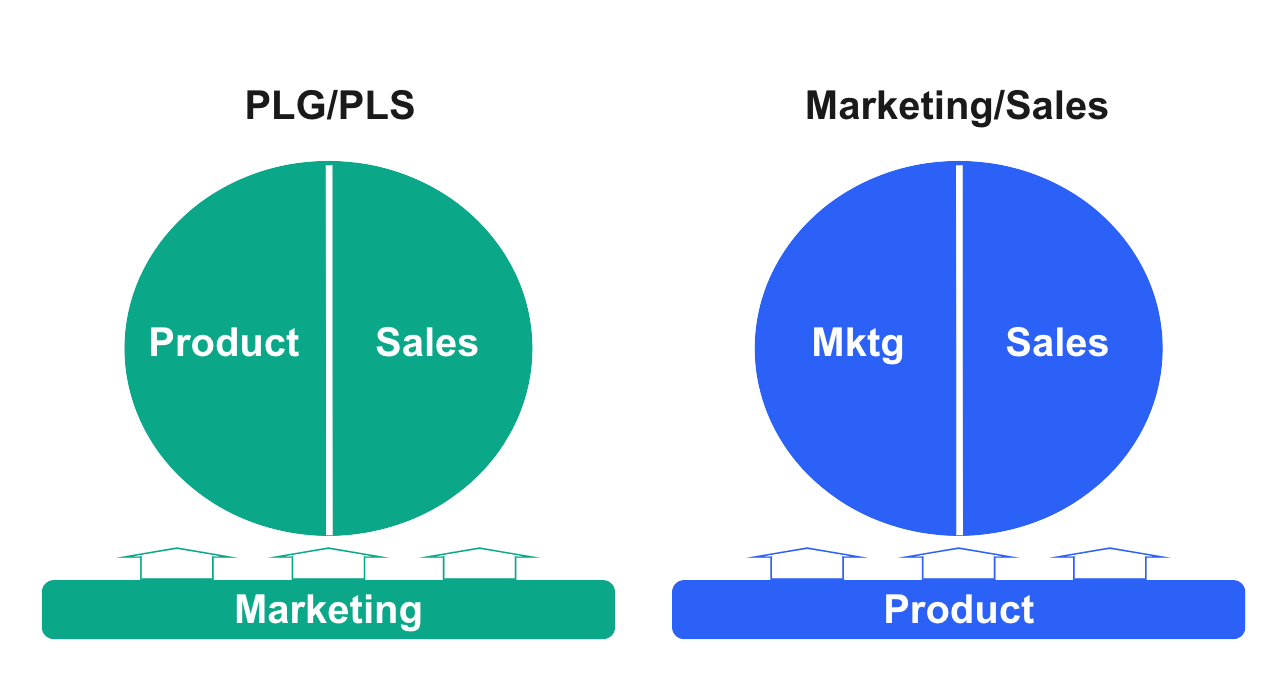
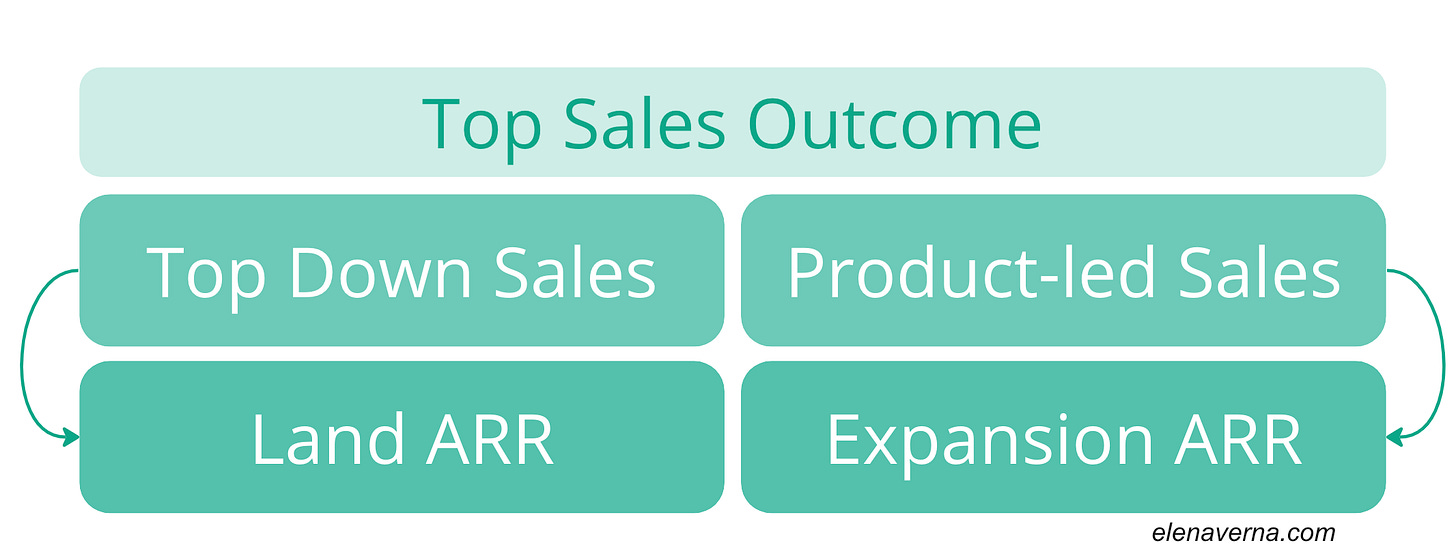
"End user is not a lead" I see a lot of companies getting confused about this recently. Great read :)
The best bit about this piece is that anyone can understand what Elena is saying. Masterpiece, Elena!